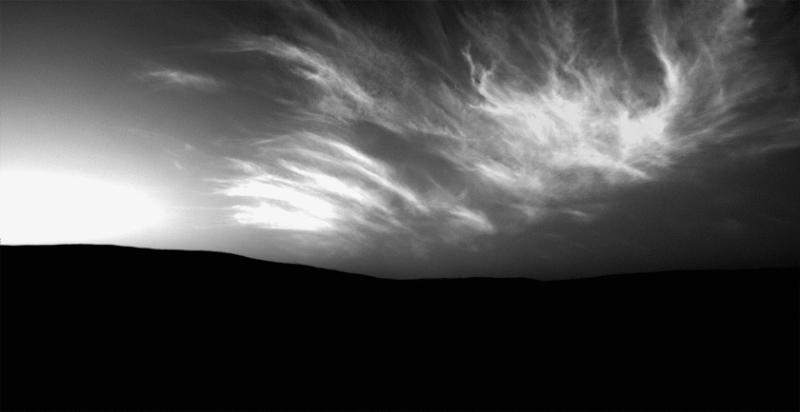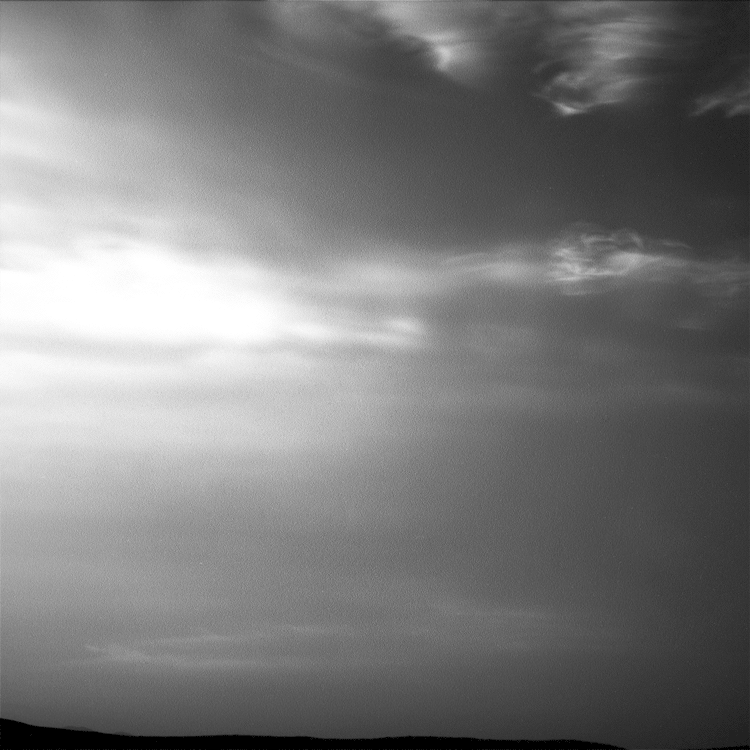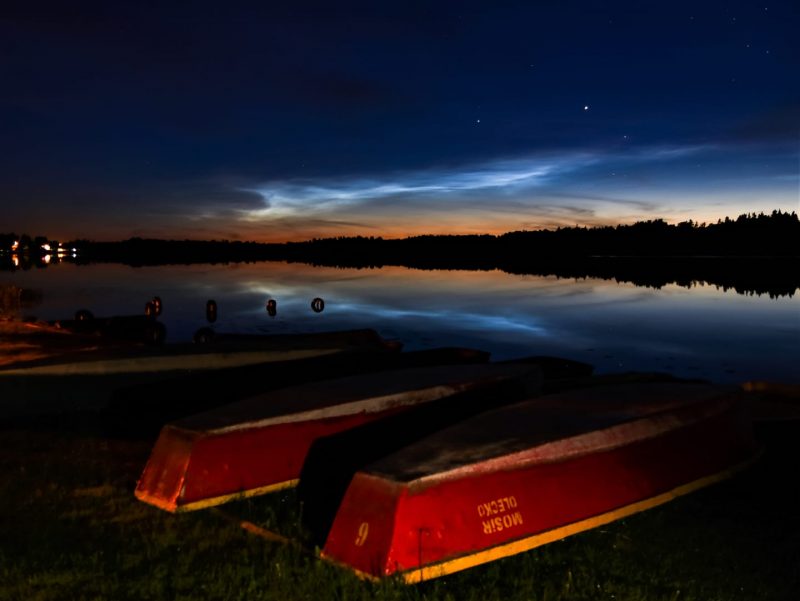

Noctilucent clouds in motion in Mars’ sky, seen by the Curiosity rover, Sol 2410. Curiosity captured these clouds on Sol 2410 (May 18, 2019). The clouds are sunlit although the sun has set; they’re noctilucent clouds or night-shining clouds. The animation was assembled from 3 sets of 3 Navcam images. Via NASA /JPL-Caltech /Justin Cowart/Planetary Society.
Emily Lakdawalla of the Planetary Society reported recently that the Curiosity rover on Mars has been seeing noctilucent – or “night-shining” – clouds in Mars’ sky. That news comes just as the noctilucent cloud season begins for the northern part of Earth, too. We’re already hearing rumblings from the Facebook group Noctilucent clouds around the world that some European skywatchers have been spotting these clouds in recent nights. More about noctilucent clouds visible in earthly skies below. First, here’s what Lakdawalla had to say about the Curiosity rover’s view of these clouds on Mars; she wrote on May 28, 2019:
Curiosity has … been looking up after sunset recently. It’s been taking Navcam photos, and the camera’s reasonably broad field of view (45 degrees) lets it take in a lot of clouds, giving all of us back on Earth a chance to see them, too. [The image at the top of this page] is a spectacular set, which included 3 sets of 3 frames that can be assembled into a panoramic animation, here assembled by Justin Cowart.
Here’s another image, acquired by Curiosity on May 27, 2019. Lakdawalla points out that, although it doesn’t animate, it does cover a huge amount of the Martian sky:
Soirée nuageuse sur Mars pour le rover Curiosity @MarsCuriosity. C'est l'une des premières fois qu'on a une vue aussi large et détaillée des nuages martiens depuis la surface.
Photo prise le 25 mai 2019.https://t.co/qal4fbTSvK pic.twitter.com/EKrHZIAOaQ— Thomas Appéré (@thomas_appere) May 28, 2019
Lakdawalla also wrote:
Prior views pointed at only one location in the sky, so they don’t have quite the impact of the panoramas. On the plus side, they contain more time steps. Here is one example.

Noctilucent clouds in motion, Curiosity, Sol 2405. Curiosity looked upward after sunset on sol 2405 (May 13, 2019) and saw wispy cirrus clouds in motion, high above the ground. Because of their high elevation, the clouds are still sunlit, making them noctilucent clouds. Image via NASA/JPL-Caltech/Justin Cowart/Planetary Society.
Lakdawalla pointed out that these images from Mars have some downsides. For one thing, she wrote:
Because they are taken after sunset, Navcam requires long exposures to produce these images: 10 to 70 seconds. These unusually long exposures emphasize imperfections within the camera, making the images look ‘snowy,’ especially the 70-second exposure. It doesn’t matter. They’re still stunning.
And she pointed out the lack of color in the images:
Navcam is a monochrome camera, so it can’t do that. Curiosity’s color Mastcam could take color pictures, but with a much narrower field of view, denying us the panoramic landscape.
And that brings us to the subject of the following images of noctilucent clouds, taken not from Mars, but from our own Earth. In earthly skies, these clouds form in the highest reaches of our atmosphere – the mesosphere – as much as 50 miles (80 km) above the surface. They’re thought to be made of ice crystals that form on fine dust particles from meteors. They can only form when temperatures are incredibly low and when there’s water available to form ice crystals.

View at EarthSky Community Photos. | Noctilucent clouds or night-shining clouds seen over the Masurian Lake District of northern Poland on June 3, 2019, via Dorota Anna.
Earthly noctilucent clouds are a seasonal phenomenon, and the 2019 season for the Northern Hemisphere has barely begun. For best results, look for these clouds from about May through August in the Northern Hemisphere, and from November through February in the Southern Hemisphere. Now the bad news. They can’t be seen from everywhere on Earth, but are a high-latitude phenomenon. You need to be between about 45 degrees and 60 degrees north or south latitude to see noctilucent clouds.
That’s why we typically see photos of noctilucent clouds in Earth’s sky from people in Scandinavian or northern European countries. Adrien Louis Mauduit – who works for the Aurora Borealis Observatory on Norway’s Senja Island – also runs the Facebook page Noctilucent clouds around the world. That page is a great resource for those who want to see noctilucent clouds, or for those who are just curious about them. Adrien reported in late May that he was seeing the beginnings of the season for these clouds. If you’re at a high latitude in the Northern Hemisphere, watch for them in the weeks ahead!
Bottom line: Images from the Curiosity rover on Mars of noctilucent clouds seen shining at night, high in the Martian sky. Also, a few early images of noctilucent clouds seen on Earth as the observing season for them begins in 2019.
Post your noctilucent cloud photo at EarthSky Community Photos
Via the Planetary Society and Noctilucent clouds around the world
from EarthSky http://bit.ly/2WemFtn


Noctilucent clouds in motion in Mars’ sky, seen by the Curiosity rover, Sol 2410. Curiosity captured these clouds on Sol 2410 (May 18, 2019). The clouds are sunlit although the sun has set; they’re noctilucent clouds or night-shining clouds. The animation was assembled from 3 sets of 3 Navcam images. Via NASA /JPL-Caltech /Justin Cowart/Planetary Society.
Emily Lakdawalla of the Planetary Society reported recently that the Curiosity rover on Mars has been seeing noctilucent – or “night-shining” – clouds in Mars’ sky. That news comes just as the noctilucent cloud season begins for the northern part of Earth, too. We’re already hearing rumblings from the Facebook group Noctilucent clouds around the world that some European skywatchers have been spotting these clouds in recent nights. More about noctilucent clouds visible in earthly skies below. First, here’s what Lakdawalla had to say about the Curiosity rover’s view of these clouds on Mars; she wrote on May 28, 2019:
Curiosity has … been looking up after sunset recently. It’s been taking Navcam photos, and the camera’s reasonably broad field of view (45 degrees) lets it take in a lot of clouds, giving all of us back on Earth a chance to see them, too. [The image at the top of this page] is a spectacular set, which included 3 sets of 3 frames that can be assembled into a panoramic animation, here assembled by Justin Cowart.
Here’s another image, acquired by Curiosity on May 27, 2019. Lakdawalla points out that, although it doesn’t animate, it does cover a huge amount of the Martian sky:
Soirée nuageuse sur Mars pour le rover Curiosity @MarsCuriosity. C'est l'une des premières fois qu'on a une vue aussi large et détaillée des nuages martiens depuis la surface.
Photo prise le 25 mai 2019.https://t.co/qal4fbTSvK pic.twitter.com/EKrHZIAOaQ— Thomas Appéré (@thomas_appere) May 28, 2019
Lakdawalla also wrote:
Prior views pointed at only one location in the sky, so they don’t have quite the impact of the panoramas. On the plus side, they contain more time steps. Here is one example.

Noctilucent clouds in motion, Curiosity, Sol 2405. Curiosity looked upward after sunset on sol 2405 (May 13, 2019) and saw wispy cirrus clouds in motion, high above the ground. Because of their high elevation, the clouds are still sunlit, making them noctilucent clouds. Image via NASA/JPL-Caltech/Justin Cowart/Planetary Society.
Lakdawalla pointed out that these images from Mars have some downsides. For one thing, she wrote:
Because they are taken after sunset, Navcam requires long exposures to produce these images: 10 to 70 seconds. These unusually long exposures emphasize imperfections within the camera, making the images look ‘snowy,’ especially the 70-second exposure. It doesn’t matter. They’re still stunning.
And she pointed out the lack of color in the images:
Navcam is a monochrome camera, so it can’t do that. Curiosity’s color Mastcam could take color pictures, but with a much narrower field of view, denying us the panoramic landscape.
And that brings us to the subject of the following images of noctilucent clouds, taken not from Mars, but from our own Earth. In earthly skies, these clouds form in the highest reaches of our atmosphere – the mesosphere – as much as 50 miles (80 km) above the surface. They’re thought to be made of ice crystals that form on fine dust particles from meteors. They can only form when temperatures are incredibly low and when there’s water available to form ice crystals.

View at EarthSky Community Photos. | Noctilucent clouds or night-shining clouds seen over the Masurian Lake District of northern Poland on June 3, 2019, via Dorota Anna.
Earthly noctilucent clouds are a seasonal phenomenon, and the 2019 season for the Northern Hemisphere has barely begun. For best results, look for these clouds from about May through August in the Northern Hemisphere, and from November through February in the Southern Hemisphere. Now the bad news. They can’t be seen from everywhere on Earth, but are a high-latitude phenomenon. You need to be between about 45 degrees and 60 degrees north or south latitude to see noctilucent clouds.
That’s why we typically see photos of noctilucent clouds in Earth’s sky from people in Scandinavian or northern European countries. Adrien Louis Mauduit – who works for the Aurora Borealis Observatory on Norway’s Senja Island – also runs the Facebook page Noctilucent clouds around the world. That page is a great resource for those who want to see noctilucent clouds, or for those who are just curious about them. Adrien reported in late May that he was seeing the beginnings of the season for these clouds. If you’re at a high latitude in the Northern Hemisphere, watch for them in the weeks ahead!
Bottom line: Images from the Curiosity rover on Mars of noctilucent clouds seen shining at night, high in the Martian sky. Also, a few early images of noctilucent clouds seen on Earth as the observing season for them begins in 2019.
Post your noctilucent cloud photo at EarthSky Community Photos
Via the Planetary Society and Noctilucent clouds around the world
from EarthSky http://bit.ly/2WemFtn

Aucun commentaire:
Enregistrer un commentaire